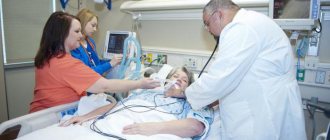Types of diabetic coma
Increased attention to the prevention of the development of diabetic comas is due to the high level of complications of these life-threatening conditions. The mortality rate for diabetic ketoacidosis (DKA) in European countries is 2-7%, in the Russian Federation 7-19% [1].
The incidence of DKA in people living with type 1 diabetes mellitus (DM) is 10-100 cases per 1000 cases. About a third of them end up in hospitals in a state of diabetic coma [2]. At the same time, competent glucose-lowering therapy can significantly reduce the likelihood of developing comatose states and delay the development of other serious complications of diabetes [1].
There are 4 types of comas that develop in diabetes:
- Diabetic ketoacidotic. In the medical literature it is also referred to as hyperglycemic hyperketonemic.
- Diabetic non-ketoacidotic hyperosmolar. It is also hyperosmolar non-acidotic.
- Lactic acidosis (lactic acidosis).
- Hypoglycemic coma [2, 3, 7].
10
REMEMBER! Hypoglycemic coma is many times more dangerous than diabetic coma, primarily due to its transience.
REMEMBER! Only a few hours can pass from the appearance of warning signs to death.
The lightning-fast course of the coma is explained by the same fatal “kindness” of insulin: when it is in excess, the doors to the cell are constantly wide open for glucose.
Having received unlimited access, it will very quickly move from the bloodstream into the tissues, and the blood sugar level will sharply decrease.
Subject to the laws of osmotic pressure, a large amount of water will rush into the cell for glucose.
Of course, the brain will be in the worst position.
The further course of events will reflect the clinical picture of cerebral edema growing hourly.
First, severe headaches, dizziness, nausea and vomiting appear. The patient begins to get tongue-tied and loses coordination of movements. His behavior changes dramatically. Excitement or euphoria quickly gives way to irritability or aggressiveness.
The flushed, sweaty face begins to make unimaginable grimaces, and the body writhes in convulsions, and within a few minutes there is a loss of consciousness. The face will turn pale, profuse sweating and vomiting will appear. Then the seizures may disappear, and the patient’s life will be in the balance.
It is difficult to imagine how much harm the warning signs of coma cause to these people.
Deviations in behavior often lead these people to the police station instead of the hospital. Or even worse - someone who has lost consciousness in a subway passage or train car is mistaken for a homeless person or a beggar who has fallen asleep.
| WALKING PAST ANYONE LYING ON THE SIDEWALK OR IN THE ELECTRIC TRAIN CAR IS A MATTER OF YOUR CONSCIENCE. |
| Harbingers of hypoglycemic coma, when the patient can be saved by two pieces of bread. | Signs of a hypoglycemic coma, when the patient’s life hangs by a thread. |
| Deviations in behavior, unreasonable fear and anxiety are the first things that attract attention. As a rule, there is an increased level of blood pressure. If you do not start providing assistance during this period, then within 15-20 minutes the patient will lose consciousness - a hypoglycemic coma will occur. | Immediately after loss of consciousness, the skin will turn sharply pale and heavy sweat will appear. The blood pressure level will significantly exceed the norm, convulsions and vomiting will appear. Death can occur within minutes. |
11
MASKS-PREDICTERS OF HYPOGLYCEMIC COMA
REMEMBER! The danger of warning symptoms is that they occur under the guise of antisocial behavior or a disease such as epilepsy.
DRUNK MASK
Indeed, what can you think about a person who screams in a subway car, gets into an argument with passengers and is extremely aggressive. His speech is slurred, but obscene language and excessive gesticulation will very quickly lead him to the nearest police station.
And then the only hope is that one of the policemen, suspecting something is wrong, will call an ambulance.
This is why diabetic patients must carry an identity document and a diabetic card.
Seizure Mask
This diabetes mask is the most dangerous. Seizures are a harbinger of death from cerebral edema, which can occur within an hour.
In this condition, diabetic patients are often mistaken for epileptics. Providing assistance during an epileptic attack involves the administration of anticonvulsants and sedatives, which poses a mortal danger during the development of a hypoglycemic coma.
MASK OF FOILiness
The patient is bothered by violent movements of the muscles of the face and limbs.
He may blink, involuntarily jerk his head, arms and legs, clap his hands or knees, his face is often disfigured by grimaces of crying or laughter. Looking at his antics, it’s hard not to laugh, but in half an hour he will be on the verge of death.
In diabetic patients, such behavioral deviations occur only in a state of hypoglycemia and disappear immediately after its elimination.
REMEMBER! A person who five minutes ago seemed like a drunken lout, after eating one or two sweets, again becomes a kind intellectual.
This is another paradox of diabetes - an extremely dangerous condition can be relieved within a few minutes with almost two pieces of sugar or white bread. The main thing is not to be late to offer them.
| If from the lips of an imaginary drunk you heard the words: “DIABETES, COMA, INSULIN,” you cannot help but come to his aid. |
| The drunken mask is the most common and insidious. Its manifestations will certainly lead to the police station, and death can occur within a few hours. | Mask of foolishness. The patient's grimaces and antics are extremely funny, but his death can occur within 1-2 hours. | The mask of a convulsive attack is the most dangerous. Seizures are a harbinger of death from cerebral edema, which can occur within an hour. |
Ketoacidotic
Hyperglycemic hyperketonemic coma is an acute decompensation of diabetes, which develops as a result of severe insulin deficiency. At the same time, there is a lot of glucose in the blood, but in the absence of insulin it does not enter the cells, so fat begins to be used as an energy source instead of carbohydrates.
Active breakdown and inclusion of free fatty acids in metabolism leads to the formation of ketone bodies. Their synthesis increases to 1000 mmol per day, which significantly exceeds the ability of the kidneys to excrete ketones in the urine [7].
Changes in blood and urine tests in diabetic ketoacidosis in adults are presented in table [1].
| Laboratory indicators | Values |
| Blood plasma glucose | >13 mmol/l to 18-20 mmol/l [3] |
| Plasma ketone bodies | >5 mmol/l |
| Ketonuria | ≥++ |
| pH | ˂7,3 |
Clinical picture and symptoms
With the development of diabetic coma, the patient develops a number of characteristic symptoms that form the clinical picture of this pathological condition. Symptoms of diabetic coma are as follows:
- Strong feeling of thirst.
- Frequent urination, while the volume of urine increases significantly and its concentration decreases.
- Severe weakness.
- Itchy skin and dry mucous membranes as a result of dehydration.
- Loss of consciousness.
- Apple odor on breath.
Clinical symptoms of acute hyperglycemia are ketoacidosis and severe dehydration. All of the above signs of a diabetic coma appear sequentially, and their severity quickly increases.
Diabetic coma: causes
The pathogenesis of diabetic coma lies in the insufficient production of the main hormone responsible for carbohydrate metabolism in the body - insulin. A deficiency of this hormone leads to the development of a serious disease – diabetes. With a sharply reduced amount of insulin in the blood, blood glucose ceases to be absorbed by the body's cells, which leads to a significant increase in its concentration in the blood and the manifestation of symptoms of diabetic coma.
Treatment
The development of diabetic coma can be prevented with specialized medical care. It is necessary to monitor the level of glycemia in the blood and select the correct dosage of insulin based on the glycemia and weight of the victim. The water deficit must be replenished - rehydration therapy is carried out. All procedures for relieving diabetic coma can be carried out at the Clinical Institute of the Brain, which employs qualified doctors who can quickly overcome such an emergency condition as diabetic coma. After stabilizing the basic functions of the victim’s body, he is transferred to hospital treatment and precise correction of the metabolic consequences of diabetic coma is carried out.
Causes
The likelihood of developing a coma due to progressive ketoacidosis increases in the following cases:
- Errors in insulin therapy.
- Increased need for insulin in pregnant women, during surgical operations, the prescription of certain drugs (glucocorticosteroids, diuretics, etc.), physical activity, and stressful situations.
- Excessive intake of easily digestible carbohydrates and fats from food in case of severe dietary violations [4, 7].
Prevention
Severe complications of diabetes can only be avoided if you strictly follow medical recommendations for controlling the disease: strict adherence to a diabetic diet, rational physical activity, timely treatment of infectious diseases, avoidance of alcoholic beverages and nicotine, and regular visits to an endocrinologist. It is strictly forbidden to independently change the regimen and dosage of prescribed medications. You should not delay visiting your doctor if you experience symptoms of illness. The development of further events can be dangerous for health and life.
Symptoms
A person with ketoacidosis' condition worsens gradually, usually over 1-2 days or more. The clinical picture is divided into 3 successive stages:
- Moderate ketoacidosis. There is weakness, lack of appetite, thirst, dry skin and mucous membranes, and frequent urination. The smell of acetone appears in the exhaled air.
- Hyperketonemic precoma. Muscle weakness, thirst, dry mouth increases. Abdominal pain, heart pain occur, and decreased vision is noted. The patient is inhibited.
- Ketoacidotic coma. The man loses consciousness. A characteristic rare deep noisy breathing appears with a noticeable odor of acetone in the exhaled air [7].
Diabetic hyperglycemic comas
In hyperglycemic comas, blood glucose levels are elevated. There are three types of hyperglycemic comas:
- Diabetic ketoacidotic coma.
- Diabetic hyperosmolar coma.
- Diabetic lactic acidemic coma.
Let's look at them in more detail.
Diabetic ketoacidotic coma
Diabetic ketoacidotic coma begins with diabetic ketoacidosis (DKA). DKA is a condition accompanied by a sharp increase in the levels of glucose and ketone bodies in the blood and their appearance in the urine. DKA develops as a result of insulin deficiency for various reasons.
Causes
- insufficient administration of insulin to patients (forgot, mixed up the dose, broke the syringe pen, etc.);
- acute diseases, surgical interventions;
- the onset of type 1 diabetes (the person does not yet know about his need for insulin);
- pregnancy;
- taking medications that increase blood glucose levels.
Due to a lack of insulin, a hormone that helps metabolize glucose, the body’s cells “starve.” This activates the liver. It begins to form glucose from glycogen stores. Thus, the blood glucose level increases even more. In this situation, the kidneys try to remove excess glucose through the urine, releasing a large volume of fluid. Together with the fluid, the potassium it needs is removed from the body.
Diabetic ketoacytosis
On the other hand, under conditions of lack of energy, the breakdown of fats is activated, from which ketone bodies are ultimately formed.
The removal of large amounts of fluid leads to dehydration, thickening of the blood and lack of oxygen in the tissues. Together with potassium deficiency, this causes symptoms of DKA.
Symptoms and signs
Ketoacidosis develops gradually over several days.
At the initial stage, the blood glucose level rises to 20 mmol/l and above. This is accompanied by severe thirst, the release of large amounts of urine, dry mouth, and weakness. Possible abdominal pain, nausea, and the smell of acetone from the mouth.
Subsequently, nausea and abdominal pain increase, vomiting appears, and the amount of urine decreases. The patient is lethargic, lethargic, breathing heavily, with an intense odor of acetone from the mouth. Possible diarrhea, pain and interruptions in heart function, decreased blood pressure.
In the later stages, coma develops with loss of consciousness, noisy breathing and disruption of the functioning of all organs.
Diabetic hyperosmolar coma
Diabetic hyperosmolar coma (DHA) is a coma that develops in conditions of large loss of body fluids, with the release of little or no ketone bodies.
Causes
- condition accompanied by large loss of fluid (vomiting, diarrhea, bleeding, burn);
- acute infections;
- serious diseases (myocardial infarction, acute pancreatitis, pulmonary embolism, thyrotoxicosis);
- taking medications (diuretics, adrenal hormones);
- heat or sunstroke.
When the level of glucose in the blood increases to huge numbers (more than 35 mmol/l, sometimes up to 60 mmol/l), its excretion in the urine is activated. A sharply increased diuresis, combined with a large loss of fluid from a pathological condition (diarrhea, burns, etc.) leads to thickening of the blood and dehydration of cells “from the inside,” including brain cells.
Symptoms
DHA usually develops in older people with type 2 diabetes. Symptoms appear gradually over several days.
Due to high levels of glucose in the blood, thirst, excessive urination, dry skin, and weakness appear. The pulse and breathing increase, and blood pressure decreases. Neurological disorders subsequently develop: agitation, which is replaced by drowsiness, hallucinations, convulsions, visual impairment, and in the most severe situation, coma. There is no noisy breathing, as with DKA.
Diabetic lactic acidemic coma
Diabetic lactic acid coma (DLC) is a coma that develops in conditions of a lack of oxygen in the tissues, accompanied by an increase in the level of lactic acid (lactate) in the blood.
Causes
- Diseases accompanied by oxygen starvation of tissues (myocardial infarction, heart failure, lung disease, renal failure, etc.).
- Leukemia, late stages of cancer.
- Alcohol abuse.
- Poisoning with poisons, alcohol substitutes.
- Taking metformin in large doses.
With oxygen starvation, excess lactic acid is formed in the tissues. Lactate poisoning develops, which disrupts the functioning of muscles, heart and blood vessels, and affects the conduction of nerve impulses.
Symptoms
DLK develops quite quickly, within a few hours. Accompanied by an increase in blood glucose levels to small numbers (up to 15–16 mmol/l).
DLK begins with intense pain in the muscles and heart, which is not relieved by taking painkillers, nausea, vomiting, diarrhea, and weakness. The pulse quickens, blood pressure decreases, shortness of breath appears, which is then replaced by deep noisy breathing. Consciousness is impaired and coma occurs.
Hyperosmolar non-acidotic
Non-ketoacidotic hyperosmolar coma also develops due to acute decompensation of diabetes. It is based on a sharp decrease in insulin levels and loss of fluid from the body. In this case, there is no excessive formation of ketone bodies and acidosis [7].
| Laboratory indicators | Values |
| Blood plasma glucose | >30 mmol/l |
| Blood osmolarity | 400-500 mOsm/l [4] |
In a general blood test, an increase in hemoglobin and hematocrit levels is noted due to a decrease in plasma volume. There is no acetone in the urine [3].
Causes
Most often, hyperosmolar non-acidotic coma develops in elderly people living with type 2 diabetes [3]. Provoking factors include any diseases and conditions in which the body actively loses fluid:
- irrational use of diuretics;
- diseases accompanied by recurring diarrhea and vomiting;
- staying in conditions that cause active sweating (working in a hot shop, moving to a country with a hot climate, etc.).
Also, this type of diabetic coma can develop with myocardial infarction, massive bleeding, and in patients on hemo- or peritoneal dialysis [7].
Hypoglycemic coma - causes, symptoms
This complication of diabetes mellitus develops due to a rapid decrease in blood glucose levels, which can be caused by an overdose of insulin or other drugs that lower sugar levels, or excessive physical activity, leading to a sharp consumption of glucose. If the patient does not eat after an insulin injection, this can also cause hypoglycemia.
The development of hypoglycemic coma is always sudden. Harbingers of an impending coma are increased anxiety, trembling, sweating, flashing “spots” before the eyes, a feeling of numbness of the tongue and lips, and a sharp feeling of hunger. In the absence of correction of the condition at this stage, the patient experiences the appearance of convulsions, agitation, and increased blood pressure. In the future, depression of consciousness, increased sweating, slowing of breathing and gradual disappearance of reflexes can be observed.
Symptoms
The patient's health deteriorates slowly over 1-2 weeks. At the precoma stage, severe thirst, dry mouth, dryness and decreased skin turgor, and frequent excessive urination are noted.
In a coma, as a result of fluid loss, the patient's facial features become sharpened, the eyeballs sink and become soft to the touch. There is no smell of acetone in the exhaled air. Various neurological disorders are characteristic: pathological reflexes, nystagmus, paralysis, epileptiform convulsions. The result of blood thickening can be thrombosis of arteries and veins [3, 7].
Lactic acidotic coma - development mechanism and symptoms
This type of diabetic coma is less common than other types, but is one of the most severe complications of diabetes. This type of coma develops as a result of a complex biochemical reaction - anaerobic glycolysis, which is one of the alternative methods of producing energy, the residual product of which is lactic acid. If in a healthy body the level of lactic acid is in the range of 0.5 - 1.4 mmol/l, then in lactic acidotic coma this figure reaches 2 mmol/l when the blood pH level drops below 7.3. In addition, there is a change in the lactate-pyruvate balance towards an increase in lactate concentration.
Lactic acidotic coma often develops against the background of shock, intoxication, sepsis, extensive blood loss, cardiovascular and renal failure. Despite the fact that the liver is normally capable of processing more than 3 thousand mmol of lactic acid, due to the state of tissue hypoxia that accompanies the above pathological processes, the ability to process lactic acid becomes significantly less than the lactate formed. If patients are given intravenous solutions containing xylitol, sorbitol, fructose and other sugars, this is also a provoking moment for the development of lactic acidotic coma.
The onset of this type of coma is usually sudden, characterized by signs of depression of consciousness (apathy, drowsiness, delirium), as well as rapid loss of appetite, nausea, vomiting, and muscle pain. Upon examination, the patient's skin is pale and cold. The effect of lactic acid on the cardiovascular system is manifested by increased heart rate, decreased blood pressure, impaired excitability and contractility of the myocardium, paresis of peripheral vessels, and collapse.
Patients with the first signs of coma need prompt hospitalization. Confirmation of the diagnosis of lactic acidotic coma is carried out based on laboratory data, namely a high concentration of lactic acid and pyruvate in the blood, as well as a violation of the acid-base balance towards acidification.
First aid
Correction of the patient's condition is carried out in a medical institution. People with moderate ketoacidosis are hospitalized in the therapeutic/endocrinology department, and in a state of precoma and coma - in the intensive care unit [4].
At home you can:
- conduct a rapid glycemic analysis if you have a glucometer;
- call an ambulance.
A person with ketoacidosis can be given 20 units intramuscularly. short-acting insulin (RAI) [4]. With moderate hypoglycemia, the patient needs to take easily digestible carbohydrates (sugar dissolved in tea, water, a piece of bread) [3].
In the emergency department, a urine test for ketone bodies is additionally performed and infusion therapy begins with the introduction of a 0.9% NaCl solution at a rate of 1 l/h [4].
First aid measures
Decompensation of diabetes mellitus
In case of primary symptoms, first of all, you need to call an ambulance. Emergency assistance before the arrival of the brigade is provided as follows:
- Place the diabetic on his side to prevent him from choking on vomit. If necessary, manually clean the mouth and airways.
- Cover the patient with a blanket to reduce heat transfer.
- Open a window to provide fresh air.
- Measure your sugar level (every diabetic has a portable glucometer).
If the patient is conscious, he should be given sweet water to drink. In case of hypoglycemia, this measure will allow you to hold out stably until the ambulance arrives. In case of hyperglycemia, it will not do much harm. Solid sweets are not suitable, since in a precomatous state, swallowing disorders (dysphagia) and chewing function develop. A person may choke. If the patient is unconscious, it is necessary to monitor the breathing rate and pulse. It is advisable to record the data. This information may be useful to the emergency doctor. If medical skills are available, resuscitation measures should begin once the person returns to consciousness.
First aid at home should be carried out with extreme caution. You cannot shake the patient, hit him on the cheeks, or pour water on him in order to bring him to his senses. A diabetic should not be given insulin until the ambulance arrives. Especially with alcohol intoxication. In most cases, a diabetic with coma symptoms is hospitalized. The hospital carries out measures for primary diagnosis and provision of resuscitation care.
Consequences
Diabetic coma has a number of adverse consequences for human health, as it contributes to the rapid progression of diabetes, disrupts or aggravates existing disorders in the functioning of internal organs. For example, older people who have suffered a hypoglycemic coma develop:
- cerebral edema (in 26% of cases);
- acute cardiovascular failure (22%);
- atrial fibrillation (13%) [6].
Fear of hypoglycemia can cause inadequate blood sugar control [5].
Hospital treatment
Sugar coma is stopped in the intensive care unit. The main goal of treatment is to restore the patient’s vitality and normalize blood sugar levels. Resuscitation measures include:
- Restoration of cardiac and respiratory activity. The patient is connected to a ventilator and given injections of cardiac medications.
- Stabilization of glycemia. For hyperglycemia, certain doses of insulin are administered; hypoglycemia involves drip administration of glucose.
- Normalization of acidity. In case of lactic acidosis and DKA, the body is alkalized with special solutions.
- Restoring electrolyte balance, removing breakdown products. Droppers with an aqueous solution of sodium chloride are used.
- Hemodialysis. The presence of renal failure is an indication for blood purification using the hardware method.
- Antishock therapy. It is carried out with hormone-containing medications (glucocorticoids).
After stabilization of the patient, a course of treatment of concomitant diseases and complications of diabetes mellitus is carried out. The rehabilitation time depends on the severity of the coma and the compensatory mechanism in the patient’s body.







